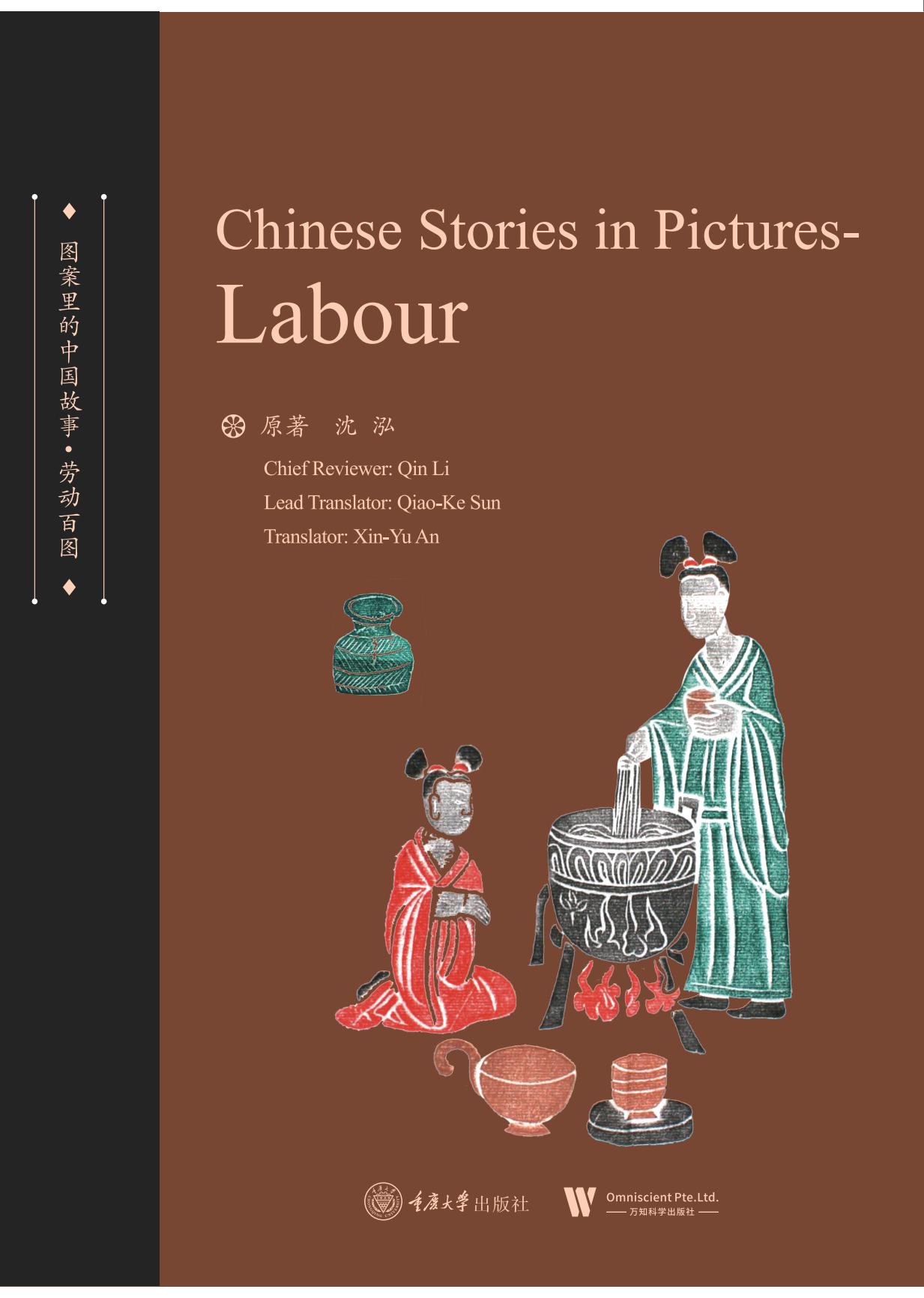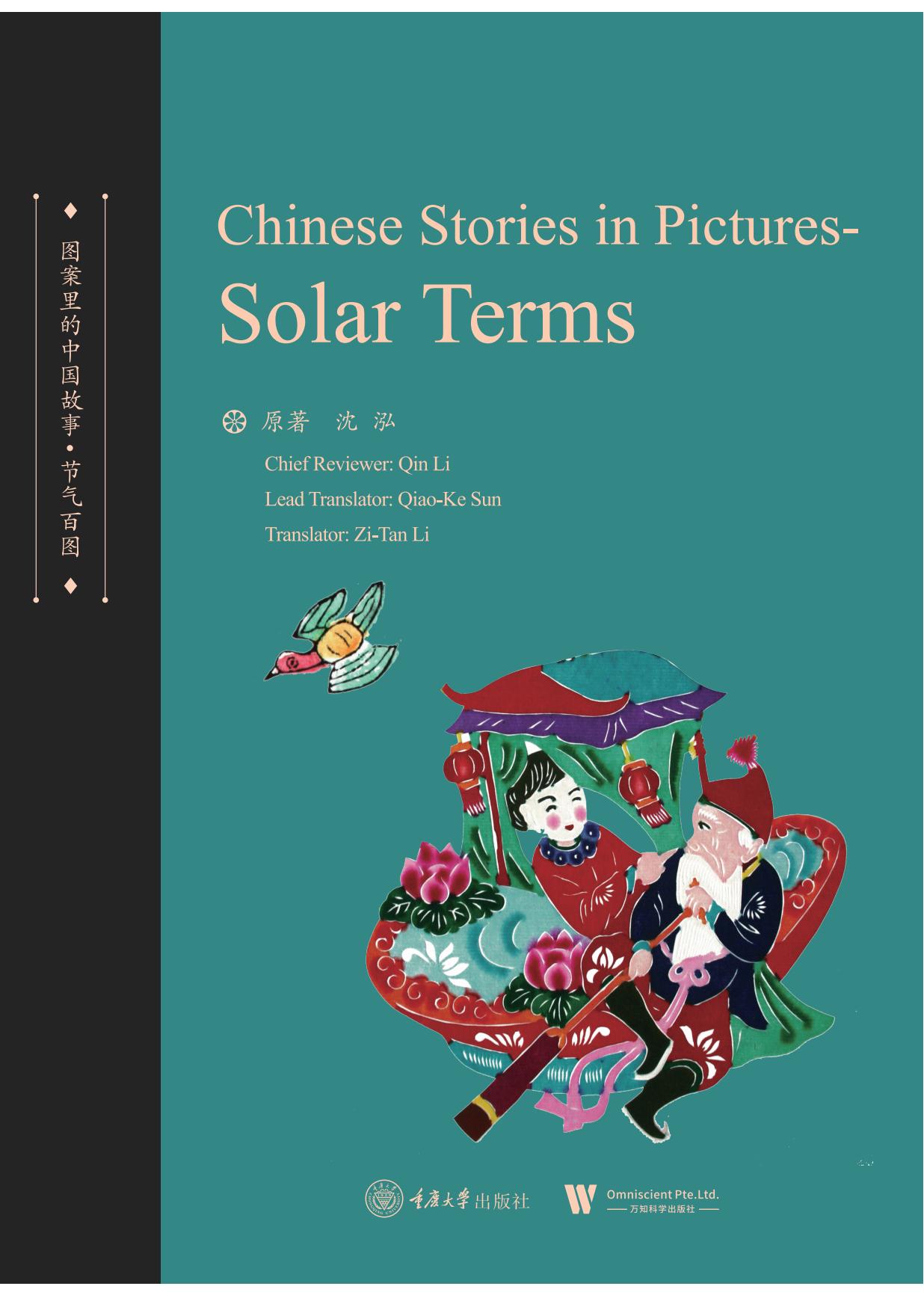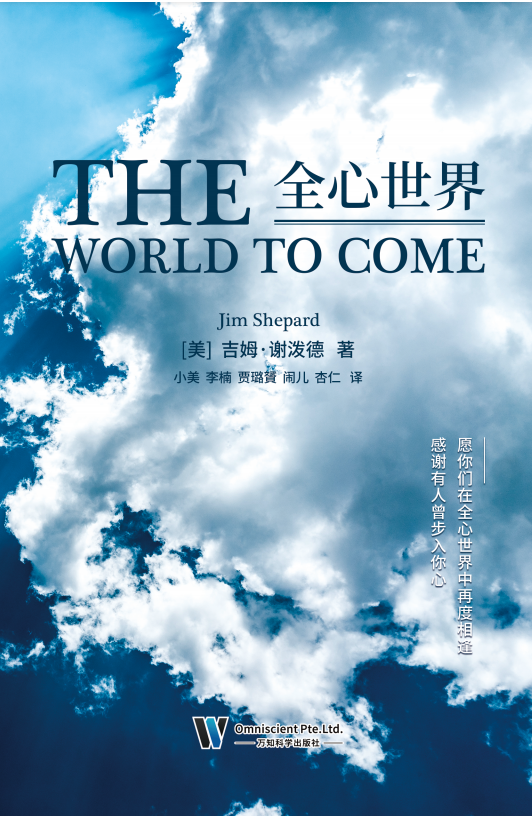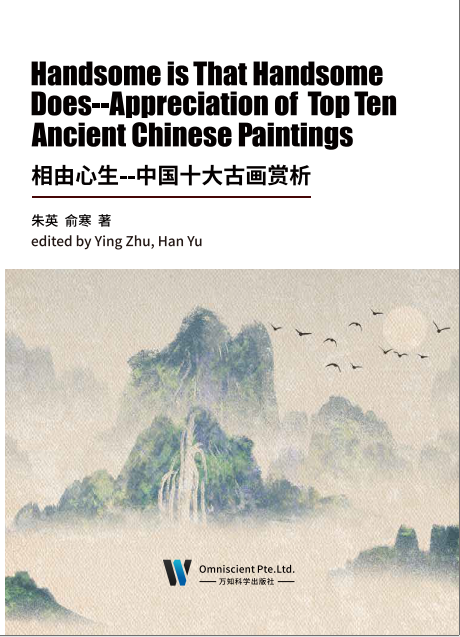
Pursuing the beauty of labour has been an essential part of Chinese people’s lives from ancient times to modern society. Chinese traditional pictures abound with various scenes depicting Chinese ancestors’ passion for and diligent engagement in labour. The types of pictures selected in this book include rubbings of Han Dynasty pictorial stone and brick, rubbings of carved stones throughout all previous dynasties, woodblock printings, and folk New Year paintings, among which the New Year pictures depicting labour theme are highlighted. These New Year pictures, found in Fengxiang, Wuqiang, Yangjiabu, Weixian, and other prefectures, narrate stories of labour and extol the beauty of labour by depicting labour-related activities, such as farming, fishing, woodcutting, textile production, and herding. These pictures embody ancient Chinese life and labour customs, record traditional Chinese stories and labour life, and recount China’s labour history across the times. Among them, the New Year pictures themed on “Fishing, Woodcutting, Farming, and Reading” display four types of professions in the ancient Chinese agricultural society, namely, fishermen, woodcutters, farmers, and scholars. The social rank of these four professions (fishermen first, woodcutters second) represents the basic lifestyle and value orientation of the Chinese Han labouring people in ancient times. The imagery of farmers and scholars reflects a philosophical concept of engaging with everyday life and dealing with the practicalities and challenges of the material world, while the imagery of fishermen and woodcutters signifies a withdrawal from worldly concerns to seek enlightenment. Thus, the four professions were a favourite subject for many ancient Chinese painters, and imgaes featuring this theme were often found on ancient artefacts such as porcelain, woodcarvings, stone carvings, and embroideries, as well as in folk New Year paintings, paper-cuttings, and other folk-art forms. It is evident that Chinese traditional labour-themed pictures not only depict the hardworking scenes of labourers at the bottom but also present the poetic sentiment and artistic conception of literati and scholars, as well as their reflections and insights on life. These pictures are real reflections of the local labour life and customs, as well as the spirit of the times. In my view, I prefer pictures depicting customs related to productive labour. Pictures of ploughing, weaving, and cotton-picking have created peaks in ancient Chinese labour-themed paintings. Moreover, compared to the divine aura highlighted in ceremonial paintings, the mainstream of New Year paintings, those labour-themed folk New Year pictures have a strong flavour of people’s real lives. Apart from the labour-related activities mentioned above, this book also presents Chinese traditional pictures depicting scenes of plucking, breeding, embroidery, and cooking. Given the broad range of topics in labour-themed pictures, this book is not able to make an inexhaustible record, but within a limited space, every effort has been made to let readers know by a handful the whole sack.
Shen Hong
Winter 2021

The traditional Chinese lunar calendar divides the year into 24 segments, for each segment is called a specific “solar term”: Beginning of Spring, Rain Water, Awakening of Insects, Spring Equinox, Pure Brightness, Grain Rain, Beginning of Summer, Grain Buds, Grain in Ear, Summer Solstice, Minor Heat, Major Heat, Beginning of Autumn, End of Heat, White Dew, Autumn Equinox, Cold Dew, Frost’s Descent, Beginning of Winter, Minor Snow, Major Snow, Winter Solstice, Minor Cold, and Major Cold. The criteria for the formulation of the 24 solar terms were developed through the observation of different periods of four seasons, the changes in climate, as well as certain natural phenomena, thus guiding agricultural affairs and farming activities throughout the year. Farmers in ancient China, apart from inventing various farming tools and the mode of deep plowing and fine cultivation, also devised a precise timeframe conducive to farming, which is foremost embodied in the 24 solar terms. The 24 solar terms originated in the Yellow River reaches of China. As early as the Spring and Autumn and Warring States periods, Chinese people had the concepts of Winter Solstice and Summer Solstice. Later, the Chinese ancestors first established four major solar terms and then eight solar terms marking the four seasons: Beginning of Spring, Spring Equinox, Beginning of Summer, Summer Solstice, Beginning of Autumn, Autumn Equinox, Beginning of Winter, and Winter Solstice. Subsequently, based on the positions of the sun and moon at the beginning and middle of each month, weather conditions, and the growth of animals and plants, people divided the year into 24 equal segments and assigned a specific name to each, resulting in the present 24 solar terms. In 104 BC, the Taichu Calendar formulated by Deng Ping and others officially included the 24 solar terms in the traditional Chinese calendar, clarifying their astronomical positions. During the Qin and Han dynasties, the 24 solar terms were fully established. The chapter “Celestial Phenomena” in Huainanzi (Masters of Huainan) of the Western Han Dynasty contains a complete record of the 24 solar terms. In the traditional Chinese calendar, a year consists of four seasons, 12 months, 24 solar terms, and 72 pentads. This timeframe serves as a guarantee for timely agriculture work throughout the year. Meanwhile, it caters to people’s desires for fortune and blessings, gradually evolving into relevant festivals and customs. For example, “whipping the spring ox” is a unique springwelcoming ritual associated with the Beginning of Spring as a long tradition. According to the Book of the Later Han Dynasty, in the third month of winter, six “spring ox” made of clay would be set up in the northeast outside the city gate to “bid farewell to the Major Cold”. This ritual later evolved into the tradition of “whipping the spring ox” on the first day of spring. Afterwards, the spring-welcoming ceremony and whipping spring ox ritual merged into one. People would strike and shatter the clay-made “spring ox” into pieces on the first day of spring to express the meaning of cherishing springtime and diligently cultivating the land. After the clay-made ox was whipped and broken, people would scramble for the broken clay pieces as a custom. This custom varied in different dynasties and regions and was once described in Tang poet Yuan Zhen’s poem “Birth of Spring”. As the spring-welcoming and whipping spring ox ritual became an important celebration, some folk artists created New Year pictures depicting this theme. On the first day of spring, county magistrates would deliver New Year pictures themed on spring ox as a tradition to promise a good harvest. According to traditional customs, pasting New Year pictures themed on spring ox on the first day of spring would signify the beginning of agricultural labour in the coming year, the hope for a good crop yield, the longing for happiness, and the prayer for fair weather. The 24 solar terms are closely related to folk culture, manifested in the fact that the solar terms themselves are folk customs. Therefore, the 24 solar terms are an important content of folk culture, while folk culture enriches and elevates the connotations of the 24 solar terms. The associated folk customs in different places make the 24 solar terms vibrant and engaging. According to the “Views on the Implementation of the Project of Inheriting and Developing Traditional Chinese Culture”, issued by the General Office of the Central Committee of the Communist Party of China and the General Office of the State Council, further efforts will be made to strengthen the academic interpretation and dynamic utilization of traditional Chinese calendars, solar terms, zodiac signs, as well as dietary practices and traditional medicine, so that their beneficial cultural values can be deeply embedded in people’s daily lives. This book showcases the lifelike scenes of the 24 solar terms through a hundred Chinese traditional pictures, such as folk New Year paintings themed on “spring ox” and “Winter’s Nine Nines Calendar”, to narrate historic culture, folk customs, and legends associated with solar terms. Humans have achieved tremendous breakthroughs and transcendence in many aspects, yet the 24 solar terms seem unsurpassable, for they still play important roles in people’s daily lives and production to this day. They are not just a tool of timeframe, but also a culture that has penetrated deep into the nature and essence of the Chinese nation, and the brilliance of its cultural wisdom has not been diminished even after a thousand years of flowing waters of time.
Shen Hong
Winter 2021

致我在新加坡的读者们!我是生活在美国东北部马萨诸塞州的吉姆·谢泼德。我的最新短篇小说集《全心世界》能够在新加坡出版,我对此倍感开心荣幸。新加坡是我一直以来都想要去游历的国家,也许在不久的将来我的确有机会成行。这本小说集里的许多故事都基于真实的历史事件:从人类最为悲剧性的一次北极探险,到一对寻常父子见证历史上最具灾难性的火山喷发,再到两位在荒野中独处、建立了终身难忘的亲密连结的家庭主妇。尽管呈现方式稍显戏剧化,但它们都展现了人类在极端情况下被激发出的智慧谋略与善良本性。让读者感到兴奋、感动、 并有所收获,是我创作这些故事的初衷。我衷心希望这本小说集能为你们带来以上这三种阅读体验,愿你们享受其中。

前 言(一)
关于这本书,真的是耗时有点长,因为每次打开画卷总有不一样的感觉,总觉得还有话讲,有时看多了画面,竟然还有一种幻觉,总觉得画面中的各类人物,花鸟虫草都在向我招手,倾诉。于是我不得不打开画卷再一次端详,对话……有时候说着说着又仿佛跟画家争吵起来,当然,我们更多的时候对酒当歌。听着他们倾诉着各自人生起伏,我只能默默地多饮几杯,无须多言,只需聆听,让他们说个够。我懂,一张画,哪是你我看到的画面,分明就是他们的人生秋歌,只是当下的大多数人只是匆匆瞥一眼他们的心血,也说不出好,或者坏,都因为冠了个名头——“十大古画”,然后才有机会亮相当下,因此他们自我感伤的中有觉得活得辛苦的,有觉得活得不够的,有觉得活得明白的,也有人觉得活得也算可以的。但凡能被千百年后的我们欣赏的,已经有着不一样的烟火,够了!
“相由心生”还不如说“像由心生”,看着眼前的一幅幅不同时代,不同皇朝,不同作者的“像”,越看越有三维空间,也蕴藏着四维世界,每一笔都是意念的传递,每一色都是认知的世间,每一物都是性相的表现。这一张张画像啊,无不就是我聆听
到的各式人心,听多了,我也便是熟悉了,然后不用抬眼寻他们,他们都在暗处看着我,但是我识相,就一一认出了他们,眼瞅着那些像,那些相,画着画着就是呐喊,画着画着就是自赞,画着画着就是消失在人间……
About this book, it really takes a long time, because every time I open the scroll, I always have a different feeling, I always feel that there is something to say. Sometimes when I see many pictures, I even have an illusion. I always feel that all kinds of people in the picture, flowers, birds and caterpillar fungus are waving to me. So I had to open the scroll to look again, dialogue... Sometimes he seemed to quarrel with the painter come on, of course, we sing to each other more often. Listening to them talk about their ups and downs, I drank more cup, don't say much, just listen, let them say enough. I know. A picture. That's what you and I are looking at the autumn song of their life, but the majority of people just glance at their efforts, also can not say good or bad, Because of the title of "ten ancient paintings", and then have the opportunity to appear in the present, so they feel sad in the live
Some feel that their life is not enough, some feel that their life is clear, and some feel that their life is ok. If anyone can be after thousands of years of our appreciation, has not the same fireworks, enough!
"Look from the heart" is better than "like from the heart", looking at the pictures of different times, different dynasties, different authors the more you look at the "image", the more three-dimensional space, but also contains a four-dimensional world, every stroke is the transmission of ideas, every color is cognition In this world, everything is a manifestation of nature. These portraits are all the hearts I have heard so many times,I knew them, and I didn't
have to look for them. They were all looking at me in the dark, but I recognized them.They stare at those images and phases, and when they draw, they cry out, praise themselves and disappear on earth.
前 言(二)
从我小时候开始,我就沉浸于一个洋溢着浓厚中国文化的家庭当中,我的母亲非常热衷于研究历史与艺术,深受她的影响,我也逐渐爱上了研究与欣赏古画。中国5000年的历史给我们留下了非常多的艺术品,让我们可以在当今现代社会通过这些画作来遐想出古代社会的痕迹与画面。为了让世界上更多的人看到中国古画的魅力与底蕴,我很荣幸承担了翻译的工作,做一位文化的传播者和传颂者。
艺术是没有壁垒的,任何不同国家的人虽然有着文化差异,但是大家都有着欣赏美的眼睛。就像世界上的各种艺术作品都有着互通与关联性。中国古画在世界各大博物馆都拥有着重要的一席之位,足以证明它的研究价值和艺术价值,那是一个国家文化的历程。古画的赏析是一门大学问,必须拥有丰富的学识和认知,才能去理解与欣赏这些古人笔下的世界,愿这本书,开启你我的艺术欣赏之旅!
Since I was a child, I have been immersed in a family full of strong Chinese culture. My mother was very keen on studying history and art. Deeply influenced by her, I gradually fell in love with studying and appreciating ancient paintings. China's 5000 years of history has left us with a lot of artworks, so that we can imagine the traces and images of ancient society through these paintings in modern society. In order to let more people in the world see the charm and heritage of ancient Chinese paintings, I am honored to undertake the work of translation, as a cultural disseminator and promoter.
There is no barrier to art. Although people in different countries have cultural differences, they all have eyes to appreciate beauty. Just like all kinds of works of art in the world are interconnected and connected. Ancient Chinese painting has an important place in the world's major museums, enough to prove its research value and artistic value, that is the process of a country's culture. The appreciation of ancient paintings is a university, and it is necessary to
have rich knowledge and cognition to understand and appreciate the world under the pen of these ancient people. I hope this book will open the journey of art appreciation for you and me!